
My first day in Hong Kong was a whiplash of taxis, neon, and lizard wine.
I’d spent the afternoon settling in, watching the world go by outside my walk-up apartment. A parade of crimson taxis, motorbikes, and utility vans drove bumper to bumper with luxury import cars. Open rooftop tour buses passed by, elevated enough that I could nearly see the color of the tourists’ eyes staring back at me through my window.
Over the next few days I watched a small-scale construction project unfold at the busy street corner. I drew in a gasp as one man climbed the bamboo scaffold with supreme ease, contorting his body like an acrobat to slip through gaps in the frame. Stretching my legs sounded like the next best thing so I set out to explore the urban landscape on my way to San Wan Ho. There, I was to meet a Hong Kong native named Mei who would take me on a “secret” food crawl through one of her favorite neighborhoods. As I meandered through switchback roads I noticed old neon signs that gave off a nostalgic glow against the setting sun.
The last hour of dusk was full of life: The clinking of glasses and serveware resounded as restaurants prepared for the night’s hungry guests. A mother and daughter were praying at a small shrine, offering a basket of oranges to the deities. The flux of business suits on the street seemed to signal the end of another long day at the grind.
A woman with a teal streak in her dark, pixie-style haircut flagged me down as I neared our rendezvous and we commenced with introductions. As we strolled along Mei gave a brief depiction of the “Fishball Revolution” that took place in Mong Kok during the Lunar New Year celebrations of 2016. Ultimately, it was a clash between police and locals over a crackdown on food hawkers that authorities had previously turned a blind eye to out of respect for the New Year tradition. It seemed to paint a deeper picture: fear of fading Hong Kong culture amidst an increasingly gentrified landscape due to pressure from China.
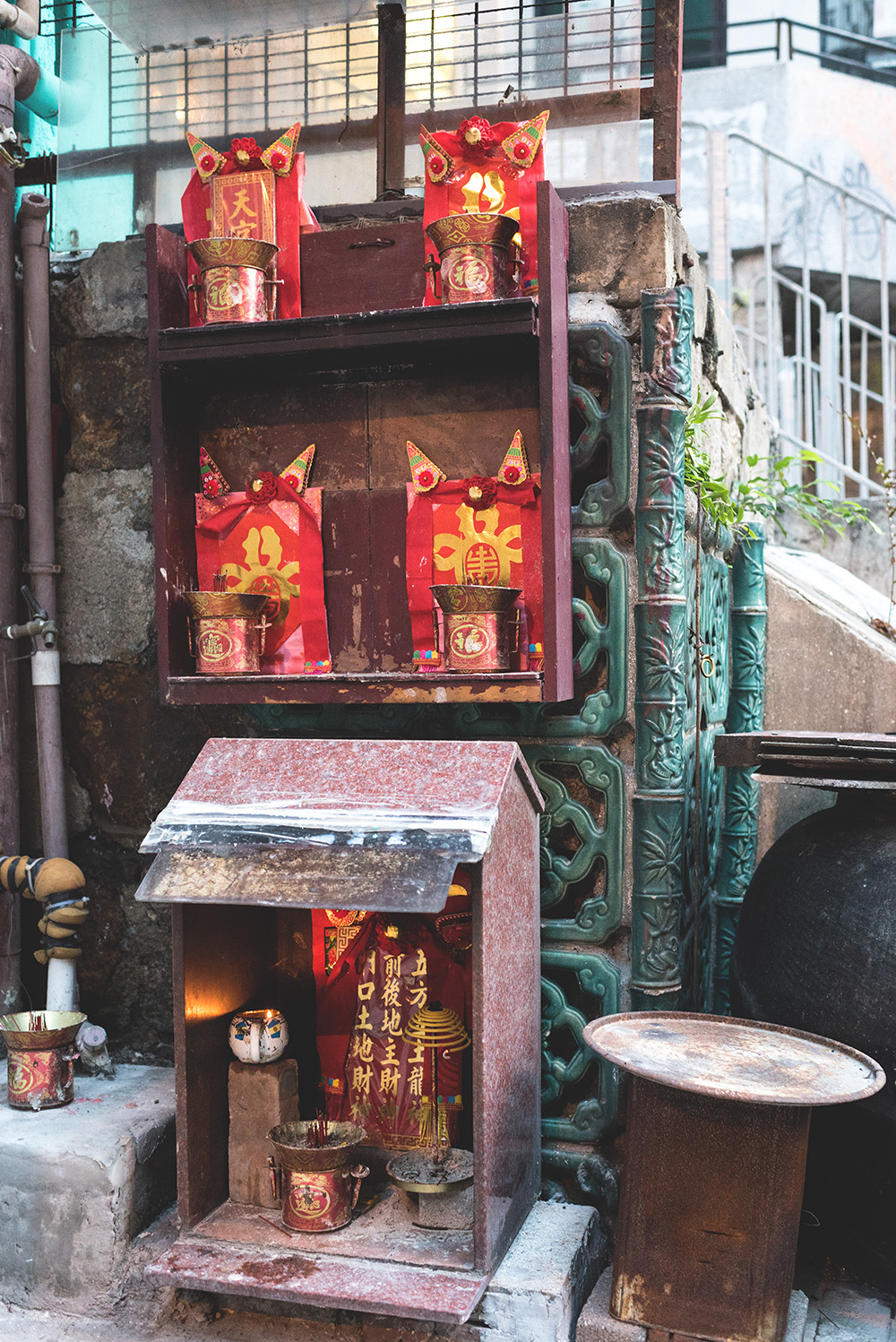
As we walked on I considered Mei’s words as I took in the convivial atmosphere around us in which a variety of dai pai dong (food stalls) were working tirelessly to satiate their customers and keep them coming back for more. Our first stop was a Haiwanese chicken-rice joint that I was informed is famous among locals, evident by the line already stretched around the corner. After our order came up we jumped into a pair of vacant plastic seats nearby, chopsticks at the ready. The steaming Styrofoam to-go containers beckoned us and so we devoured our highly-anticipated prize without words. As promised, it was some of the best chicken I’d ever tasted.
Just next door was our second stop of the evening and a right of passage: egg waffles. The stall proudly displayed newspaper clippings everywhere in sight as proof of their undeniable quality. This iconic dessert is made by pouring batter between two searing iron demi-sphere molds, creating a look akin to bubble-wrap. This sweet sanctuary also specialized in another style of Hong Kong waffles that were crispy on the outside yet dripping with sweetened condensed milk, peanut sauce, and crunchy peanuts. We ordered both.
With our sweet tooth satisfied for the moment we headed off for another course of savory. I followed Mei blindly into the sticky, sweltering night. For the second time that evening I noticed people camped outside a building with blankets and bags in a fairly uniform line. Catching my gaze, Mei explained, “They’re not homeless – they’re waiting.” Apparently, queuing up for anything from a release of the latest tech to procuring a seat at a popular restaurant is ingrained in Hong Kong culture.
Ten minutes later we arrived at a nondescript crimson door that opened upon our advancement. The middle-aged proprietor looked questioningly at Mei who proceeded to fire off in rapid Cantonese, slowing only to enunciate one particular word. The man smirked at her candor and showed us to a table surrounded by wooden stools. Mei turned to me with a wink and whispered, “I called him handsome when I asked for a good table.” The tiny restaurant was packed with locals absorbed by the feast before them. Soon Mr. Handsome appeared with a pad of paper and jotted down Mei’s order, considering each item with a slight tilt of his head.

A myriad of unrecognizable dishes came not five minutes later, followed in quick succession by snake soup, congee, roast pork, and goose with skin so thickly lacquered that I could nearly see my reflection in it. We washed everything that touched our lips down with glasses of lizard wine, a curious substance which resembles brandy yet goes down a little harshly to the uninitiated. “Gom bui!” Toasting each other, we refilled our glasses once more.
“Did you know,” Mei said between sips, “that Hong Kong men and women have the highest life expectancy in the world?” Astonished, I told her I had thought that title belonged to Japan. “Nope, we’re just above them,” she confirmed. I recalled the sugary, calorie-dense dishes we’d consumed that night, fishing for an explanation as to how this was possible. “Ah,” Mei replied with a pseudo guilty smile, “after all this we go and cleanse ourselves by drinking tons of medicinal tea. Very effective.” With that, I made a mental note to add some of this magical remedy to my morning routine.
After receiving a few invaluable restaurant tips from Mei, we said our goodbyes. As my lodging was close by I decided to walk off the multi-course meal I had just devoured. The sounds of raucous nightlife emanating from the bars was almost as deafening as it was off-putting. Amidst the late-night drunken discord I spotted an elderly woman roughly seventy years of age, her back permanently hunched over at an alarming angle. In a jarring contrast to the scene around her she quietly pushed her cart through the trashed streets, pausing to collect cardboard remnants from liquor cases. It was difficult to witness, like watching a real-time movie highlighting the immense disparity between the designer-brand-toting youth and the aging lower-income population.
I couldn’t get the image out of my mind well after I had found my way back to the room. Later on, I found out that these “cardboard nannies” are quite commonplace in Hong Kong’s aging society – a product of gaps in financial protection from their government and lack of community support. The disturbing scene from late that evening seemed to burn into my eyelids as I eventually drifted off to sleep.
I awoke the next morning to the familiar sounds of power tools and traffic. Upon peeking through my window I was greeted by hues of the brightest pinks; It looked as though a flower festival was taking place across the street. Boxes upon boxes of silken beauties were being hand-carried into the building that was being developed. For what, exactly, I had yet to discover. I decided that I would make it my mission to find out by the end of my visit. With that anticipation in the back of my mind I started getting ready for the day ahead.
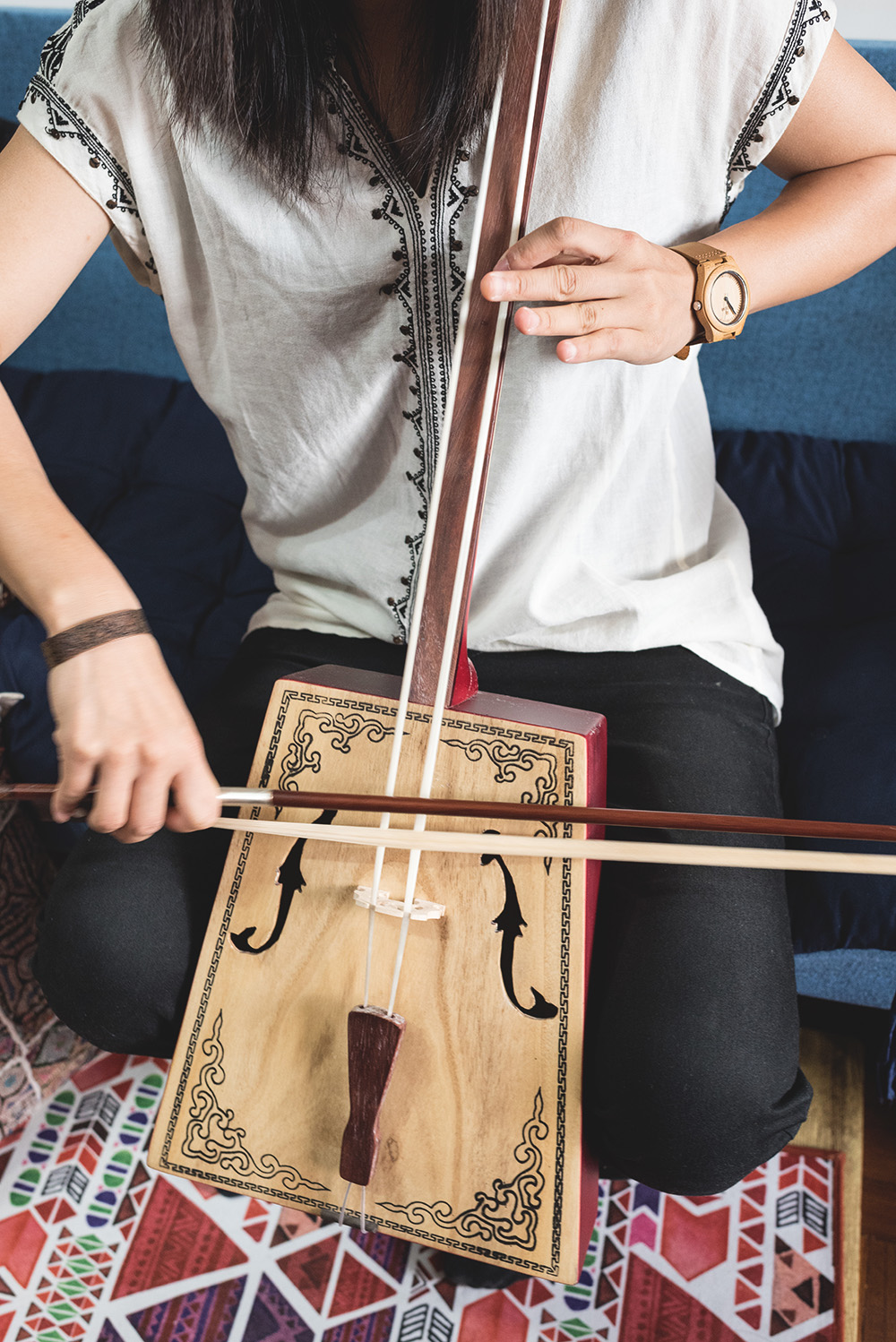
Soon, I was on my way to Kowloon, egg tart in hand – a portable breakfast from a popular bakery along my route. The sweet fragrance of the flower district followed me until I had stopped abruptly in front of an emerald green gated door. I was fairly certain I had just arrived at my destination. Earlier, I had tracked down a Chinese string instrument enthusiast in hopes of hearing traditional music in Hong Kong.
I knocked twice, tentatively, and a young woman of Chinese descent named Esther smiled and beckoned me into her home. After offering me tea we sat down, surrounded by a generous assortment of instruments, many of which I did not recognize.
What intrigued me the most was the guzheng, a type of zither with upwards of sixteen strings. Esther centered herself in front of it and began to pull rubber bands over her fingers, each with a plastic nail extension, giving the striking appearance of fierce talons. At once she gracefully plucked away at the strings in chords, building upon a harmonious melody that filled the air. It was something reminiscent of a harp and piano duet. I forgot where I was for a moment as I closed my eyes and willed myself to preserve the heavenly sound in my memory.
She trailed off and went on to perform with a few other instruments such as the erhu, zhongruan, and a string version of a xylophone known as a yangquin,which with one uses small wooden hammers to make a sound. I tried my hand at each, only to come to the conclusion that Esther is insanely talented.
I had been hoping to visit an erhu artisan to photograph how the instrument is made, but couldn’t find any such person still operating a business in the area. Upon further research I found that erhu production has primarily been reduced to certain provinces of China. In fact, although I had originally come to Hong Kong to document various artisans, I didn’t find many. I was saddened to discover that times are changing; traditional crafts are dying with their last masters as there is no one to take over and learn the necessary techniques. The next generations are more interested in pursuing tech and finance careers in the city than spending the time to dedicate themselves to one particular art.
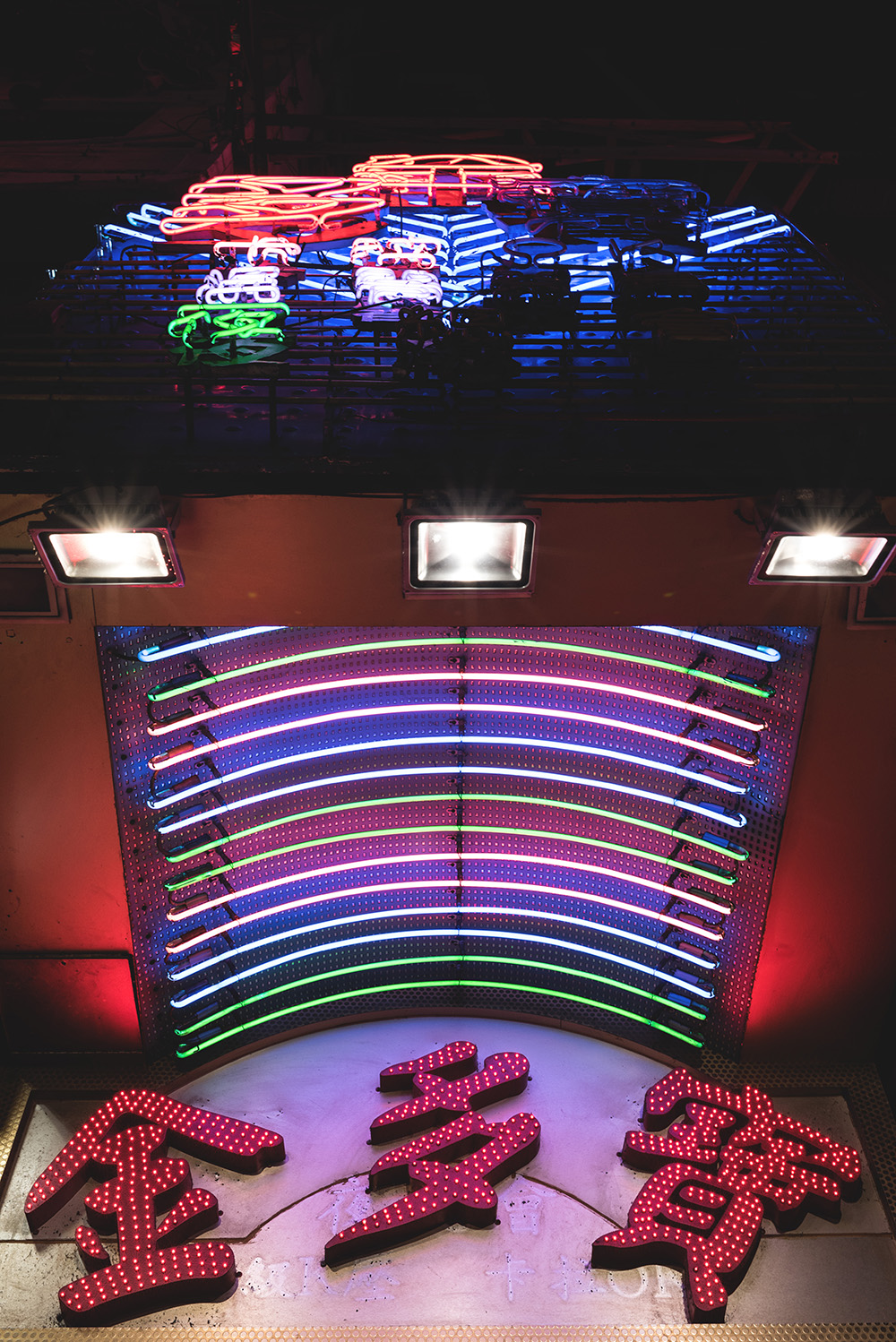
After professing my gratitude for an afternoon of enchantment I bid Esther a warm farewell and headed off in search of my next adventure within the old neighborhoods of Kowloon to see another fading art: neon signs. The atmosphere changed the closer to downtown I got with increasingly dilapidated buildings and a higher frequency of 24-hour massage parlors were offering the lowest rates I’d seen yet.
Suddenly, I found myself in the midst of bright, vivid lights hanging every which way and reaching out into the middle of the road. After wandering the streets and basking in neon glow, I heard the sound of a woman’s voice warbling a jovial tune into the night and I set off to investigate. An entire section was closed off to traffic; an open-air scene of people dancing spiritedly across the asphalt was visible to every passersby.
Though I couldn’t understand the lyrics it was beautiful to witness. After a while I wandered back to the rail station to catch a train back to Hong Kong Island where I was to meet up with a woman named Virginia who would be the host for a unique dining experience. She founded Humid with a Chance of Fishballs, an independent food tour company that appealed to my more adventurous food preferences. We would soon be enjoying a multi-course seafood feast on a traditional sampan boat in Causeway Bay.

Introductions were given among the two other guests and myself outside a convenience store. We purchased some cans of the extremely popular Blue Girl Beer to accompany our meal and slipped them into our bags. Just ahead at the docks we saw a man in full business attire who seemed to be waiting for something out on the water. Curious, I followed his gaze to a small wooden boat that a dark figure was steering towards us with aid from a long pole. “It’s a water taxi,” Virginia announced as she pulled out her cell phone, “I’ll call for one now that will take us to the sampan.”
A few minutes later she waved out into the abyss and sure enough I caught a glimpse of multi-colored Christmas lights that adorned the rickety-looking boat and a small flag rippling in the evening breeze. Carefully climbing aboard we found ourselves a seat on rainbow plastic stools and off we went, our captain maneuvering through a sea of boats and smaller yachts. We watched the glittering reflections of the looming skyscrapers across the bay, their brilliant forms dancing on the surface.
A row of sampan boats caught my attention. The scene looked as though an exterior wall had been sliced off a small apartment complex; several decorated “rooms” bobbed side by side with families and friends enjoying dinner. Laughter and bubbles of conversation were audible from the adjacent boats on the bay as we approached from the water taxi. A lady stood at the helm of the closest vessel, transfixed upon our emerging forms. Another woman smiled at us out from under a hanging tarp.

We stepped aboard and sat ourselves down at a picnic table. The smell of whatever the cook had in store for us was tantalizing, wafting over to us in clouds. To make the wait go by faster as our stomachs whined with hunger, Virginia unzipped her bag to produce a bottle of Chinese brandy. We cheered with a customary chorus of “gom bui” which more or less translates to “empty the cup.” We were pleasantly interrupted by the gracious ladies carrying plates of Typhoon Shelter-style cuisine right to our table.
The display was brilliant: razor clams with enoki mushrooms and green bean noodles, Chinese kale, blanched prawns, noodles stir-fried with bean sprouts, clams in black bean sauce, and typhoon shelter crab. The latter was the highlight of the feast. The name is said to have originated from the shelters that fishing boats occupied during typhoons. The dish itself is comprised of whole crabs, sautéed garlic, scallions, red hot chili peppers, and black beans. It’s an example of the distinct cultural identity of sampan fishing families who even developed their own dialect, setting themselves apart from the rest of Hong Kong.
Virginia told us that the Typhoon Shelter culture is disappearing with the changing times, despite its nostalgic appeal. Upon hearing this, I couldn’t help but think about all the indications of Hong Kong’s transforming cultural identity I had witnessed in just the couple days I’d been there. Contemplating, I sat back and watched the lights shimmering across the water. I felt so small, seeing the abundance of twinkling skyscraper lights, reflecting on the millions of people who live in the city, each with their own unique story to tell. Our plates bare, we concluded the evening with a final clink of glasses and thanked the ladies for one of the best meals of our lives, proceeding then to head back into the night the way we came.

The following morning I decided to make my way over to the construction site to investigate as planned. There, I found a woman wearing blue latex gloves in front of a large wire netting. She was thoughtfully placing an arrangement of silk flowers one by one into the grid, forming an aesthetically-pleasing wall that embodied Spring. She kindly let me photograph her as she worked, telling me it would become the display window of a jewelry store. With a smile and a bow I thanked her for her time and continued towards my destination.
I took the Mass Transit Railway as far North as I could before transferring to the Eastern line to get to the Sha Tin Station. A Hong Kong native named Lin was waiting for me there where we were to make a journey together through the Northern Territories to Tai Po via bicycle. Under cover of a bubblegum-pink baseball cap, a fox-eyed woman smiled and waved me over as I stepped off the train. “Welcome to The Northern Territories,” she said, guiding me out of the station. I knew I was in for an adventure, with Lin being a previous Hong Kong food and culture columnist.
A few minutes later we paused at what appeared to be a covered concert stage: A woman decked out in an outrageously bright garment was singing her heart out to an audience of roughly fifty people. As it turned out, karaoke was held every Sunday in that particular community, and anyone with enough courage could take the spotlight for a song or two. Noting the convivial atmosphere in appreciation, we pressed on to the bike rental shop where we tested out the braking system on our chosen rides.
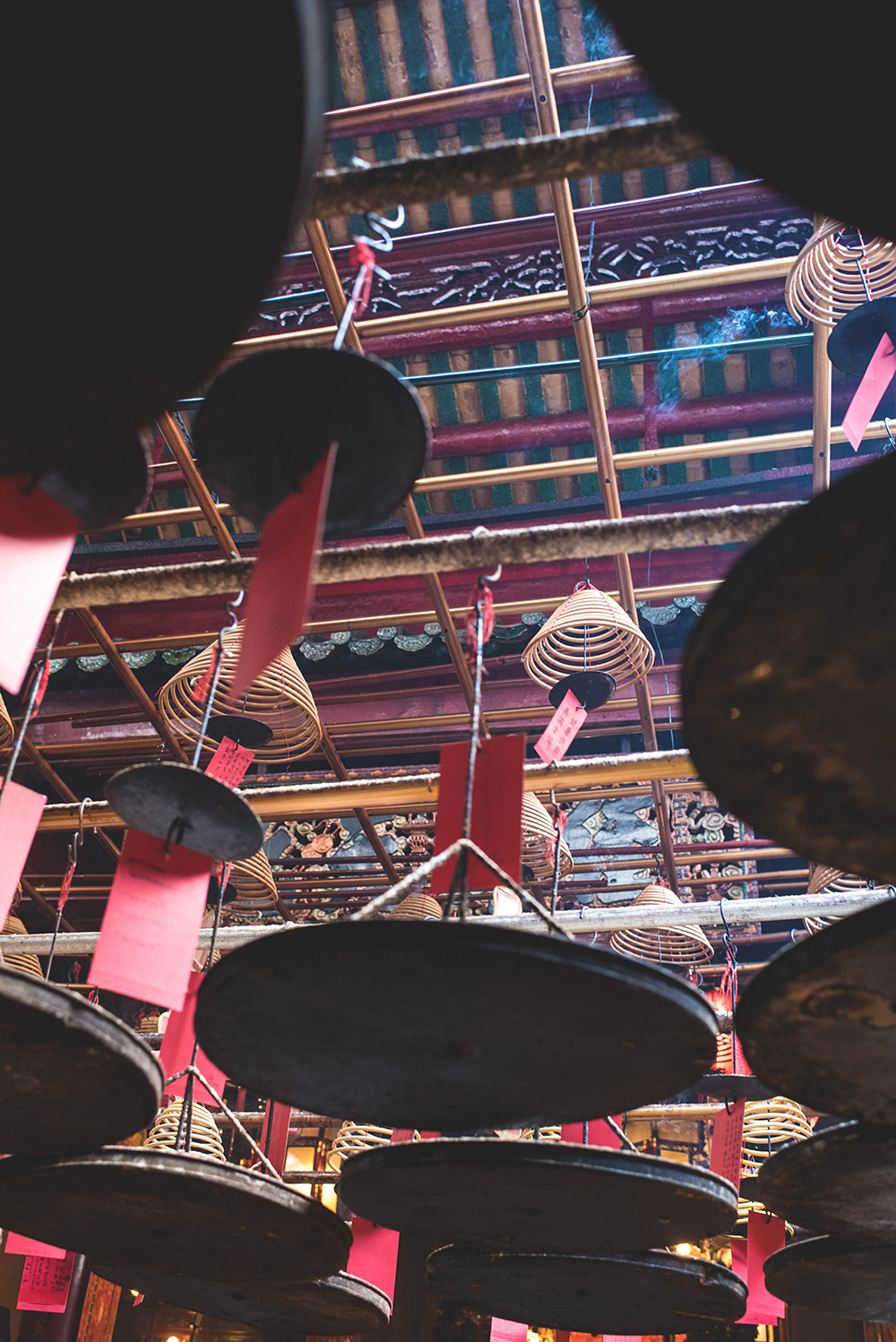
There is something so wonderfully freeing about the wind in one’s hair and seeing the world go by more slowly, as opposed to train travel where everything seems to whip by in an instant. We rode less than a mile before we found ourselves in front of the great Che Kung temple. Named to honor a famous general from the Southern Song Dynasty, the completion of this Buddhist temple’s construction in Tai Wai was said to have stopped an epidemic of cholera in the village. Lin regaled me with its history, to which I took to understand that Che Kung was revered as a God for honorable deeds carried out during his life. It is said that he helped the Song emperor flee to the South when under attack by Genghis Khan, and that where they settled is now known as the New Territories. The enormous gilded statue of Che Kung loomed over us as we prayed for the health of those dear to us.
A golden 1950’s style table fan was stationed in plain sight, the edges of which were worn down by thousands of worshipers turning the fan blades three times for good fortune. Softly stepping through the temple I took note of the unusual offerings arranged before the statues; there were oranges and an assortment of fruits as usual, but also candy bars and a bottle of peanut oil. A spurt of giggling echoed through the temple and I turned to see two Thai ladyboys in neon miniskirts and heels, iphones in hand, posing and snapping away. The contrast of the scene was something I’ll never forget.
We made our way outside where the incense smoke furled around us. My eye caught a glint of something shiny nearby: pinwheels the color of a late Summer sunset were twirling madly with each passing gust of wind. Exchanging smiles at the cathartic scene, we found our bicycles and continued onward. Riding side-by-side when the space allowed, we talked about differences between the people of Hong Kong and Mainlanders – a topic I’d heard conflicting opinions on during my brief visit.

Lin explained to me that in Hong Kong it is considered taboo to hurt one another. In Mainland China, there are issues where corporations often cut corners, sacrificing safety and quality in return for cheaper materials in order to make a bigger profit margin. She reminded me of the 2008 tragedy where over 300,000 babies became sick due to the chemical compound melamine (often used in the manufacturing of plastics) that was added to infant formula. More than ten years later there is still great distrust in certain Chinese products. Now, many Mainlanders travel over the border to shopping malls in Sha Tin just to buy quality products and clothing for peace of mind. Lightening the subject, she went on to tell me about a Facebook page offering free share rides from Tai Po to Hong Kong Island, where many of them work. She looked directly at me and simply said, “We take care of each other here.”
We rode through Hong Kong’s “Silicon Valley,” a tech sanctuary comprised of bright new buildings glistening in the middle of the Northern Territories. Further on, I marveled at a temple complex across the Tolo Harbour near Plover Cove Reservoir, glowing in the low-setting sun. Lin made an odd sort of grimace which upon my inquisitive eyebrow raise she let out a chuckle. It turned out that the gorgeous, mysterious monument in the distance was the Tsz Shan Buddhist Monastery with a colossal statue paying tribute to Guanyin Bodhisattva. I stood silent, waiting for the punch line. Apparently, this glorious ancient Buddhist temple sits upon a mountain with switchback roads leading to a collection of housing complexes named “Beverly Hills.” My gawking expression was enough to send Lin into a fit of laughter.
We conquered a few more miles of riding along that scenic stretch hugging the water before we arrived in Tai Po to return our bicycles. The final rays of sunlight were slipping through the mountains, casting a gentle glow over the village as we continued on foot. Lin motioned towards a tall building complex – one of many in this area. By her comparison, public housing in Tai Po is a little less expensive than the rest of Hong Kong and is ideal for those who do not wish to commute to the city centers every day. Each building has almost everything one could need, such as grocery stores, dentists, and doctors. All the essentials are in one place, including jobs for those who want to work within the complex.
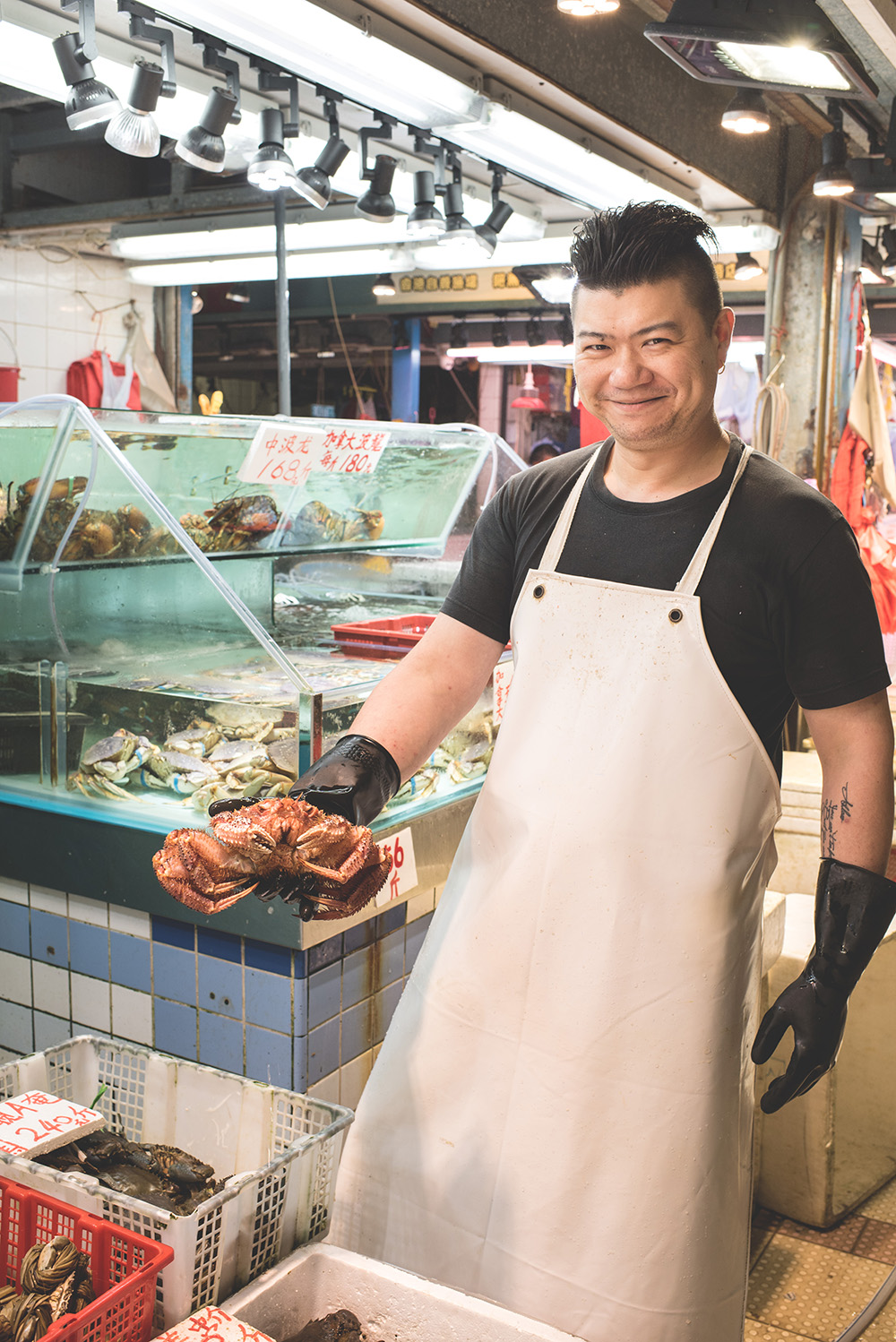
She explained that if one’s income is below a certain level they may qualify to pay six times as less for housing. We wandered around until I started to feel the hunger rise like a tiger in my belly after hours of cycling, so we headed to the Tai Po wet market to choose our meal from the daily catch. Before us stood rows of stalls featuring tanks filled with an extensive variety of aquatic creatures. The scent of the sea washed over me like a wave. Lin informed me on the history of the market and then proceeded to let out a tiny chuckle. She mentioned the famed “market prince,” an especially handsome fisherman who all the ladies fawn over. He wasn’t there, but I was able to meet two other fishermen Lin knew personally and they told us what was good that day.
After I stared in awe of all the brilliantly-colored fish we selected some razor clams, scallops, and crabs. Grinning from ear to ear, one of the fishermen proceeded to dangle a particularly large crustacean a good arm’s length away from his body while posing for a picture. With our seafood bounty all bagged up we followed the stairs up to see where the magic happens. We found ourselves in a food court setting, already in full swing with an audible energy buzz. Families were crowded around large tables overflowing with various steaming dishes. Lin handed off our bag of goodies to her favorite restaurant to prepare for us, and I pulled up a plastic stool at the only open table. Glancing around I saw stacks of bamboo steamers teetering precariously against a wall; there was a contrast of age visible by the dark patina of the well-worn.
A door banged open and a procession of fresh-cooked seafood made its way out of the kitchen: gigantic scallops on the half shell, garlic perfumed stir-fry crab, and a myriad of mollusks. Soon after it was our turn to enjoy fruits of the sea such as those and they did not disappoint. An almost overwhelming sensation of tastes, textures, and aromas filled our small space. I knew then that I was going to crave the whole experience again the next day, but alas it was my last night in Hong Kong and I would have to leave with only this memory to keep me satiated until the next time. We parted ways at the train station, with Lin giving me an insider’s tip on where to take in the best views of Victoria Harbour. I thanked her for her generosity and time to show me a side of Hong Kong I would have never seen otherwise, and we waved goodbye.
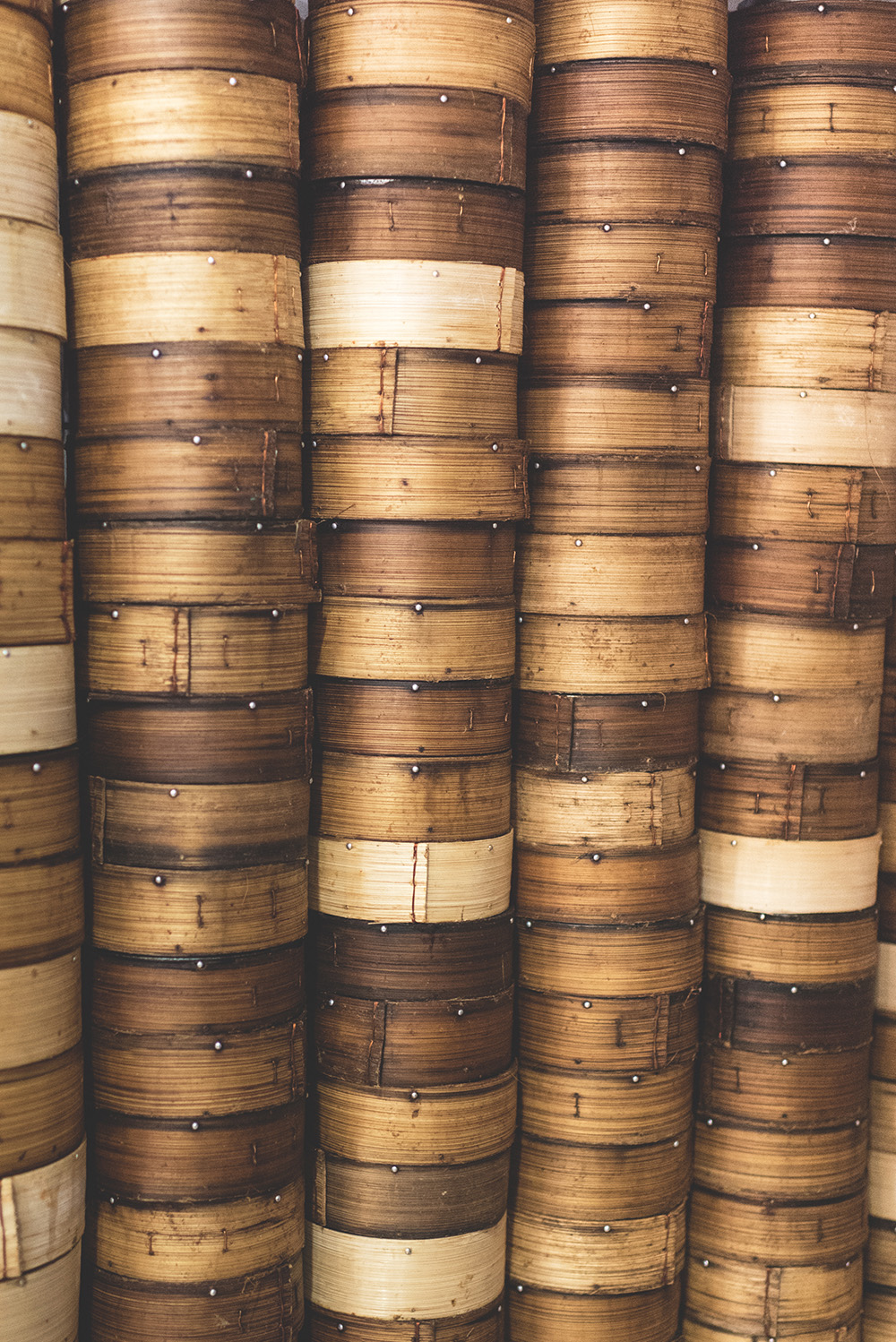
As the train sped towards Kowloon I reflected upon the past few days. Hong Kong is a mashup of rich history and vibrant cultures, and like anywhere in the world, has both commendable attributes and disconcerting ones. Wealth disparity stares you in the face at almost every turn, and the struggle to find balance between a more traditional way of life and the rapid rise of a tech-based society is staggering. I wonder if artisans will be able to persevere with their craft, or if it will all fade away into the past. More pressing is the issue of space maximization and the development of nano flats, which seems daunting and unethical.
On the other hand, it is true that they currently have the highest life expectancy in the world, potentially due to accessible health care, ease of public transport available, and an abundance of food choices that include primarily vegetables and fish. Hong Kong also has many green spaces for people to enjoy a range of activities in, existing as a reprieve from the hustle of their surrounding environment. Organizations such as Rooftop Republic work to cultivate urban areas all over Hong Kong, installing small farms in which children can learn where their food comes from, endowing the next generations with a greater comprehension of sustainable lifestyles. Amidst all this I have witnessed beauty in the details of everyday life.
Even in my short time there I was able to see communities gathering together in lively expressions through music and dance. To catch a glimpse of Hong Kong in motion I took to the streets where the neon glow and bustling energy can be seen as the sun sets. The melodic clinking of glasses in a “gom bui” surrounded by friends and family while filling your belly at a dai pai dong after a long day is cathartic. The diverse culinary spectrum remains abundant with flavors I’d never before imagined, and their innovative cocktail scene is a delight to the senses. I remember that express feeling of wonder when I got lost exploring switchback roads; I contemplated the origin of old treasures found in antique markets. Banyan trees towered over me, their roots clinging to concrete walls. People were practically bathing in swirls of incense as they prayed at a shrine on the side of a busy road.
The sticky heat makes you crave the cool touch of the surrounding beaches’ stunning crystal blue waters and take to island hopping for a taste of the freshest seafood around. Amidst the hustle of Hong Kong there appears to exist a sense of calm – one that you can find within the walls of many grand ornate temples, lush mountains trails with staggering views, and when escaping to remote fishing villages. When I close my eyes I can still hear the entrancing melody of the guzheng filling the air around me, calling me back. A desire burns within me to dig deeper into this land of contrasts. Until next time, Hong Kong.

